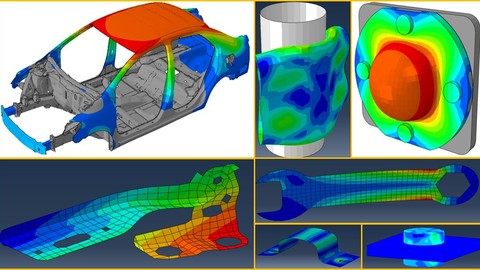
Abaqus CAE: A Detailed Introduction to Structural Analysis
Abaqus CAE: A Detailed Introduction to Structural Analysis, available at $49.99, has an average rating of 4.5, with 98 lectures, based on 33 reviews, and has 178 subscribers.
You will learn about Prepare entire model setup in Abaqus CAE Independently perform static and dynamic analysis Co-relation of CAE results with manual calculations Review of results given by CAE software Linear and Non-Linear Analysis Perform different types of analysis on 1D, 2D and 3D elements This course is ideal for individuals who are Mechanical, Automobile and Aerospace Engineers or Anyone who wants to get into CAE or finite element analysis field It is particularly useful for Mechanical, Automobile and Aerospace Engineers or Anyone who wants to get into CAE or finite element analysis field.
Enroll now: Abaqus CAE: A Detailed Introduction to Structural Analysis
Summary
Title: Abaqus CAE: A Detailed Introduction to Structural Analysis
Price: $49.99
Average Rating: 4.5
Number of Lectures: 98
Number of Published Lectures: 98
Number of Curriculum Items: 98
Number of Published Curriculum Objects: 98
Original Price: ₹799
Quality Status: approved
Status: Live
What You Will Learn
- Prepare entire model setup in Abaqus CAE
- Independently perform static and dynamic analysis
- Co-relation of CAE results with manual calculations
- Review of results given by CAE software
- Linear and Non-Linear Analysis
- Perform different types of analysis on 1D, 2D and 3D elements
Who Should Attend
- Mechanical, Automobile and Aerospace Engineers
- Anyone who wants to get into CAE or finite element analysis field
Target Audiences
- Mechanical, Automobile and Aerospace Engineers
- Anyone who wants to get into CAE or finite element analysis field
-
Course Overall Theme
Hello Everyone, I welcome you all to the new course on Abaqus CAE in our orville academy’s library.
Center focus of the course is to make you familiar with static and dynamic analysis. Course Start with introduction to theoretical concepts which we need during the course, so even if you are beginner and don’t know from where to start, well this course is perfect place for you. Course has been divided to into multiple sectionswhich covers everything that you need to know to start working or execute project independently. Wherever possible, More attention was given to verifying the CAE solution with manual calculations. Various tips, tricks and industry insights are given during the course so user can align themselves with how people working in organization think or do things.
-
Course Structure
Below is the detailed outline of the various topics covered in the course.
Section 1 : Theory of CAE/FEA
-
Product Lifecycle Management
-
Degree of Freedom
-
Methods to Solve Engineering Problem
-
Intuition of CAE Software’s/Tools
-
CAE and it’s Domains
-
Steps in FEA
-
FEA and Interpolation Function
-
Types of Numerical Methods
-
Types of Elements
-
Linear vs Non-Linear & Steady vs Transient
-
Types of Structural Analysis
-
Implicit vs Explicit Schemes in FEA
Section 2 : Introduction to ABAQUS CAE
-
Overview and Launching ABAQUS CAE
-
Graphical User Interface (GUI)
-
Interacting with Model
-
Understanding Overall Procedure : Model Setup, Solution and Visualization
-
1D Analysis Setup : Cantilever Beam
-
Typical Procedure : 2D Element
-
Typical Procedure : 3D Element
-
Revision : Analysis Setups 1D, 2D and 3D
Section 3 : Geometry Creation
-
Sketcher Options : Part-1 ,2,3
-
Sketcher Exercise : 1
-
Sketcher Exercise : 2
-
Sketcher Task : 1
-
Sketcher Task : 2
-
Creating Datum Features : Points, Axis, Plane and SYS
Section 4 : Linear Static Structural Analysis
-
Overview
-
Mesh Convergence : Part-1,2
-
Mesh Convergence : Exercise
-
Example : Pressure Load on U Shaped Bracket
-
Tips & Tricks : Saving Display Settings
-
Example : Beam Bracket
Section 5 : File Structure and Dictating Abaqus Jobs
-
Input File
-
.dat File
-
.msg File
-
.sta and Remaining Files
-
Output Formats in Abaqus
-
Performing Multistep Analysis
Section 6 : Buckling Analysis
-
Introduction to Buckling Analysis
-
Cases of Column Buckling Failure
-
Example Case 1 : Fixed – Free End
-
Example Case 2 : Pinned – Pinned End
-
Example Case 3 and Case 4 : Fixed – Pinned, Fixed-Fixed End
-
Example : Mobile Tower Buckling
-
Example : Spring Buckling
Section 7 : Non-Linear Analysis
Introduction to Non Linear Analysis
Controlling Non-Linear Analysis
Concept of Step, Increment and Iterations
Types of Geometric Non Linearities
Example : Geometric Non-Linearity
Example : Stress Stiffening
Theory : Material Non-Linearity
Example : Material Non -Linearity
Section 8 : Modal Analysis
Types of Dynamic Analysis
Overview of Modal Analysis and It’s Importance
Governing Equation : Modal Analysis
Example : Understanding Rigid Body Modes Part-1,2
Understanding Mechanism Modes
Avoiding Resonance : Example Plate
Mode Participation Factor and Effective Mass
Example Pre-Stress Modal Analysis : Plane Wing
Section 9 : Damping
Theory : Damping
Example : Spring Dashpot Damping
Section 10 : Harmonic Analysis
Theory of Harmonic Analysis
Example – 1 : Fixed Fixed Beam Part – 1
Example – 1 : L Shaped Bracket
Example – 3 : Guitar
Section 11: Explicit Analysis
Implicit vs Explicit Methods/Schemes/Analysis
Concept of Timestep : Part – 1,2
Course Curriculum
Chapter 1: Theory of CAE/FEA
Lecture 1: Product Lifecycle Management
Lecture 2: Degree of Freedom
Lecture 3: Methods to Solve Engineering Problem
Lecture 4: Intuition of CAE Software's/Tools
Lecture 5: CAE and it's Domains
Lecture 6: Steps in FEA
Lecture 7: FEA and Interpolation Function
Lecture 8: Types of Numerical Methods
Lecture 9: Types of Elements
Lecture 10: Linear vs Non-Linear & Steady vs Transient
Lecture 11: Types of Structural Analysis
Lecture 12: Implicit vs Explicit Schemes in FEA
Chapter 2: Introduction to ABAQUS CAE
Lecture 1: Overview and Launching ABAQUS CAE
Lecture 2: Graphical User Interface (GUI)
Lecture 3: Interacting with Model
Lecture 4: Understanding Overall Procedure : Model Setup, Solution and Visualization
Lecture 5: 1D Analysis Setup : Cantilever Beam
Lecture 6: Typical Procedure : 2D Element
Lecture 7: Typical Procedure : 3D Element
Lecture 8: Revision : Analysis Setups 1D, 2D and 3D
Chapter 3: Geometry Creation
Lecture 1: Sketcher Options : Part-1
Lecture 2: Sketcher Options : Part-2
Lecture 3: Sketcher Options : Part-3
Lecture 4: Sketcher Exercise : 1
Lecture 5: Sketcher Exercise : 2
Lecture 6: Creating Shapes : Part – 1
Lecture 7: Creating Shapes : Part – 2
Lecture 8: Creating Datum Features : Points, Axis, Plane and SYS
Chapter 4: Linear Static Structural Analysis
Lecture 1: Overview
Lecture 2: Mesh Convergence : Part-1
Lecture 3: Mesh Convergence : Part-2
Lecture 4: Mesh Convergence : Exercise
Lecture 5: Example : Pressure Load on U Shaped Bracket
Lecture 6: Tips & Tricks : Saving Display Settings
Lecture 7: Example : Beam Bracket
Chapter 5: File Structure and Dictating Abaqus Jobs
Lecture 1: Input File
Lecture 2: .dat File
Lecture 3: .msg File
Lecture 4: .sta and Remaining Files
Lecture 5: Output Formats in Abaqus
Chapter 6: Buckling Analysis
Lecture 1: Introduction to Buckling Analysis
Lecture 2: Cases of Column Buckling Failure
Lecture 3: Example Case 1 : Fixed – Free End
Lecture 4: Example Case 2 : Pinned – Pinned End
Lecture 5: Example Case 3 and Case 4 : Fixed – Pinned, Fixed-Fixed End
Lecture 6: Example : Mobile Tower Buckling
Lecture 7: Example : Spring Buckling
Chapter 7: Non-Linear Analysis
Lecture 1: Introduction to Non Linear Analysis
Lecture 2: Controlling Non-Linear Analysis
Lecture 3: Concept of Step, Increment and Iterations
Lecture 4: Types of Geometric Non Linearities
Lecture 5: Example : Stress Stiffening Simply Supported Beam
Lecture 6: Example : Geometric Non-Linearity
Lecture 7: Theory : Material Non-Linearity
Lecture 8: Example : Spring Plate
Lecture 9: Introduction To Contacts
Lecture 10: Procedure to Create Typical Contact
Lecture 11: Types of Contacts in ABAQUS
Lecture 12: Example : Contact Analysis Part – 1
Lecture 13: Example : Contact Analysis Part – 2
Chapter 8: Modal Analysis
Lecture 1: Overview of Modal Analysis and It's Importance
Lecture 2: Governing Equation : Modal Analysis
Lecture 3: Example : Understanding Rigid Body Modes Part-1
Lecture 4: Example : Understanding Rigid Body Modes Part-2
Lecture 5: Understanding Mechanism Modes
Lecture 6: Avoiding Resonance : Example Plate
Lecture 7: Mode Participation Factor and Effective Mass
Lecture 8: Example Pre-Stress Modal Analysis : Plane Wing
Chapter 9: Damping
Lecture 1: Theory : Damping
Lecture 2: Example : Spring Dashpot Damping
Chapter 10: Harmonic Analysis
Lecture 1: Theory of Harmonic Analysis
Lecture 2: Example – 1 : Fixed Fixed Beam Part – 1
Lecture 3: Example – 1 : Fixed Fixed Beam Part – 2
Lecture 4: Example – 1 : Fixed Fixed Beam Part – 3
Lecture 5: Example – 2 : L Shaped Bracket
Chapter 11: Explicit Analysis
Lecture 1: Concept of Timestep : Part – 1
Lecture 2: Concept of Timestep : Part – 2
Lecture 3: Example : Wave Propagation in BAR
Lecture 4: Effect of Mesh on Stable Time Increment
Lecture 5: Example : Pipe Impact
Lecture 6: Example : Cylinder Impact
Chapter 12: Project : Two Story Building
Lecture 1: Project Overview
Lecture 2: Modelling of Two Story Building
Lecture 3: Assigning Material, Property and Creating Mesh
Lecture 4: Setting Up a Deck For Static Analysis
Lecture 5: Post-Processing : Static Analysis
Lecture 6: Modal Analysis
Lecture 7: Design Proposals Based on Modal Analysis
Instructors
-
Orville Academy Plus
CAE Analyst at reputed MNC
Rating Distribution
- 1 stars: 0 votes
- 2 stars: 0 votes
- 3 stars: 4 votes
- 4 stars: 10 votes
- 5 stars: 19 votes
Frequently Asked Questions
How long do I have access to the course materials?
You can view and review the lecture materials indefinitely, like an on-demand channel.
Can I take my courses with me wherever I go?
Definitely! If you have an internet connection, courses on Udemy are available on any device at any time. If you don’t have an internet connection, some instructors also let their students download course lectures. That’s up to the instructor though, so make sure you get on their good side!
You may also like
- Best Public Speaking Courses to Learn in March 2025
- Best Affiliate Marketing Courses to Learn in March 2025
- Best Email Marketing Courses to Learn in March 2025
- Best Social Media Management Courses to Learn in March 2025
- Best SEO Optimization Courses to Learn in March 2025
- Best Content Creation Courses to Learn in March 2025
- Best Game Development Courses to Learn in March 2025
- Best Software Testing Courses to Learn in March 2025
- Best Big Data Courses to Learn in March 2025
- Best Internet Of Things Courses to Learn in March 2025
- Best Quantum Computing Courses to Learn in March 2025
- Best Cloud Computing Courses to Learn in March 2025
- Best 3d Modeling Courses to Learn in March 2025
- Best Mobile App Development Courses to Learn in March 2025
- Best Graphic Design Courses to Learn in March 2025
- Best Videography Courses to Learn in March 2025
- Best Photography Courses to Learn in March 2025
- Best Language Learning Courses to Learn in March 2025
- Best Product Management Courses to Learn in March 2025
- Best Investing Courses to Learn in March 2025






















